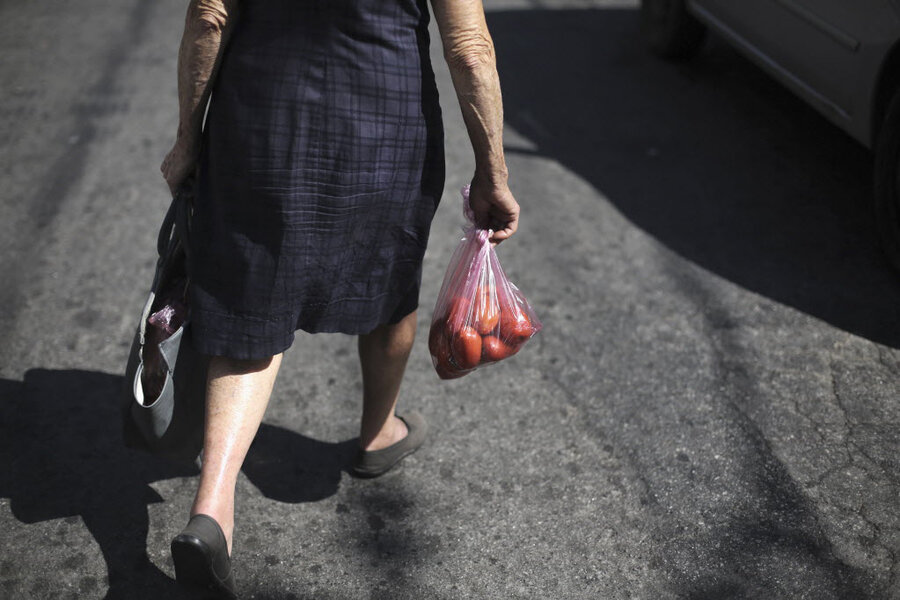Is Brazil feeding the world as Brazilians go hungry?
Loading...
| Rio de Janeiro
What do soccer stars and soybeans have in common? Brazil is incredibly good at producing and exporting both.
But while the soccer stars will come home to play for Brazil in the 2014 World Cup, the country's food exports are feeding the world as millions of Brazilians themselves go hungry, according to agriculture researchers and food scholars.
The competing interests between export demand and domestic need were underscored in an Oct. 16 report from the Global Harvest Initiative (GHI), a private advocacy group comprised of members DuPont, Elanco, IBM, John Deere, and Monsanto.
Brazil, according to the report, has increased its agricultural output by 120 percent over the past 20 years and is an example in the “success” of liberalizing trade and adapting private sector technologies.
But consideration of whether to label Brazil a "success" must also include an assessment of the country's ability to actually feed its entire population, and its capability to continue ramping up food production, says Lester Brown of the Food Policy Institute. The United Nations identifies 7 percent of the population as malnourished, while a 2010 report from the International Institute for Sustainable Development labels nearly a third of Brazil’s 199 million people as facing food insecurity, meaning that they do not eat enough or well enough.
Social equality is also suffering amid an increase in large-scale farming, says Mr. Brown. Nearly half of all Brazilian farmland is today held by the top 2 percent of landholders, a trend driven by big agribusiness and global trade markets, according to Brazil's Landless Worker's Movement. “Once you reach that concentration it’s difficult to reverse,” says Mr. Brown.
Environmental concerns are also in play, as Latin America’s role as a source of critical biodiversity should be considered in the global equation for food security, says Rolf Wachholtz, a Brazil-based agricultural economist for the International Center for Tropical Agriculture. “Brazil is far away from taking to account correct pricing and the livestock lobby will do everything to avoid changes,” Mr. Wachholtz says. “The environmental damages, especially from deforestation, will be enormous if Brazil is going to produce more meat for China.”
Brazil is the world’s top exporter of soy and poultry, much of which is feeding a growing middle class in China that is forecast to triple to 950 million by 2030, according to GHI. China is increasingly looking to production from Brazil, where annual agricultural production growth of 4.3 percent has the country on pace to produce twice what it needs to feed its own population by 2030.
“Agricultural production in Brazil far exceeds local demand, and the country is a reliable source of commodities for food-importing countries such as China,” according to the report.
Many independent experts disagree with that assessment, however.
“When you have over 13 million people who are not able to eat enough every day, we need to address this before we say whether Brazil can feed the world,” says Hugo Melgar-Quinonez, director of the Institute for Global Food Security at McGill University in Quebec.
Mr. Brown of the Food Policy Institute also questions whether future growth in Brazilian food production can continue at the current pace. Soy production will likely slow, he argues, as the legume is unassisted by fertilizers, meaning that an increase in the yield can only happen if land access increases as well.
“I’m not as impressed with Brazil as this report [from Global Harvest Initiative] appears to be,” he says.
To be sure, hunger can’t be blamed simply on exports or the government, which has in recent years introduced initiatives like the Zero Hunger Program and the More Food Program, which aim to increase food access and organize small farms. The discrepancy is also due to a lack of access to food, either because of poverty or poor distribution between areas that are food-rich and food-poor.
Brazil produces enough food to meet demand, but “due to the country’s highly skewed income distribution, the lowest-income population segments are consuming less than their basic nutritional requirements," according to the International Institute for Sustainable Development. Essentially, the poor cannot afford food produced within their own country, and farms are incentivized to export their crops amid rising international market prices for soy and grains.
End poverty, therefore, and you can end hunger, says Dr. Eugenio Diaz-Bonilla, senior research fellow at the International Food Policy Research Institute and a board member of the Inter-American Development Bank.
“If you solve poverty, then solve issue of food security,” says Dr. Diaz-Bonilla.








